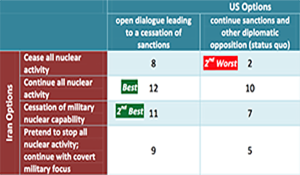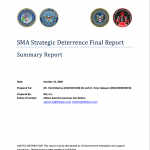Subjective Decision Analysis: Egypt, Iran, Iraq, …

Subjective Decision Analysis Final Report: Egypt, Iran, Iraq, Russia, Saudi Arabia & Syria.
Author | Editor: Astorino-Courtois, A., Canna, S., Chapman, A., Hartman, A. & Pagano, S. (NSI, Inc).
The SMA Strategic Deterrence effort is a methodological study to evaluate the appropriateness and utility of modeling and wargaming to support the analytic requirements of the Deterrence Operations Joint Operating Concept (DO JOC). The objective of the study is to determine which aspects of deterrence operations and planning can be appropriately analyzed through gaming, and which aspects can be appropriately analyzed through different forms of modeling. The project also examines the synthesis of deterrence gaming and modeling, how the results of gaming can inform deterrence modeling, and how modeling can shape deterrence gaming.
The SMA Deterrence project explored the methodologies and potential contributions of nine distinct data collection, modeling, and wargaming approaches. It addresses both their relationships to each other in support of deterrence planning, and their ability to directly support the deterrence assessment and planning process employed by U.S. Strategic Command (STRATCOM). The approaches included in the study include:
- The current practice employed by the Strategic Deterrence Assessment Lab (SDAL) at STRATCOM to develop analysts and documents with deep understanding of the decision making environment of an adversary, as well as that adversary’s decisions of interest to the United States. It uses a qualitative cost-benefit-analysis methodology.
- The capability analysis approach used by Lawrence Livermore National Laboratory (LLNL) focused on assessing a particular actor’s ability to develop, manufacture, and proliferate a specific capability.
- The extended open source elicitation analysis employed by the Institute for Defense Analyses (IDA) which looks to collect qualitative data concerning the reactions and perspectives of the people themselves on an issue. This is done through a series of interviews with regional experts who have studied the area in question.
- The Gallup World Poll which characterizes countries’ thoughts on economic and social issues through surveying individuals in over 150 countries.
- The causal diagramming and system dynamics approaches as used by PA Consulting to model entities and their relationships initially through causal diagrams and then through equations that capture historical relationships, to explore causality and the driving factors of actors’ decisions.
- The strategic wargame approach used by the ODNI-NIC and their contractor SAIC which attempts to simulate a series of events and players’ reactions to gain insight into motivations and effects of particular occurrences; they allow the government to look at strategic and operational issues in a very non-threatening way before a crisis occurs.
- The subjective decision analysis approach employed by the NSI team which uses a cognitive decision approach to develop an understanding of how an actor’s interests and perceived options, as well as those attributed to perceived rivals, affect its decision making and behaviors.
- The social network analysis approach employed by the NSI team which focuses on gaining a holistic view of how people are connected through modeling social structures.
- The GLASS (Gallup Leading Assessment of State Stability) stability model employed by Gallup
which estimates the potential for latent instability or unrest, and traces the instability back to its causes, through a model built on accurate poll data within the country(ies) of interest.
In order to achieve the program objectives, the study incorporated a limited analysis of a specific deterrence scenario. The extended open source elicitation, capability analysis, and Gallup World Poll were used as data generation methods. The causal diagramming and system dynamics model, subjective decision analysis, social network analysis, GLASS model, and regional wargame were used to analyze various aspects of the deterrence scenario. In addition, a methodology and integration study was conducted using the current SDAL practice as a baseline. This study examined the utility, costs, and means of integration of the approaches exercised in the program as well as seventeen additional data generation and modeling approaches of potential relevance to deterrence analysis and planning.
This Summary Report provides an overview of the key analytic and methodological findings of the project. Detailed descriptions and the complete reports and products of the expert extended open source elicitation, causal diagramming/system dynamics, subjective decision analysis, social network analysis, GLASS modeling, as well as the overall Methodology & Integration study are provided as appendixes to this report. The results of the wargame are contained in a separate classified report at the SECRET level.

Comments